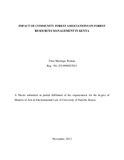| dc.description.abstract | This study sought to assess the impact of Community Forest Associations (CFAs) on forest resources management in Kenya by exploring the experiences of implementing Participatory Forest Management (PFM) under the Constitution of Kenya 2010 and the Forests Act, 2005. In recognition of the importance of forests, the Constitution obligates the State to increase tree cover to 10% of the country‟s total land area, the internationally recommended minimum for ecological sustainability. It devolves the country into 47 counties. One of the objects of devolution is to recognize the rights of communities to manage their own affairs and further their development. The Constitution therefore reinforces the Forests Act, 2005 that aims at decentralizing the management of forests through formation of CFAs. The study focused on Sururu CFA involved in participatory forest management (PFM) of Sururu forest block as part of Mau forest in Kenya. Semi structured questionnaires were administered to randomly selected 36 CFA and 32 non-CFA members. This was complimented with facilitation of 10 focus group discussions and 10 key informant interviews. Data collected indicate that Sururu CFA is responsible for diverse management activities in forest protection, monitoring and management, yet access to decision-making, revenue streams, and overall resource control rights are vested in the Kenya Forest Service. Furthermore, the viability of Sururu CFA is threatened by leadership wrangles, local institutional overlaps, and the splintering of groups. The findings suggest that the benefits of participation in Sururu forest management tend to accrue unevenly among different groups of local people. This is due to weak legal framework, unequal access to information and differences in initial resources and social position. Four major recommendations arise from the study: First, there are challenges relating to the clarity of the forest-related mandates of the national and county governments as envisaged under the Constitution. These challenges should be addressed to avoid potential conflicts between the national and county governments over management of forests. Second, institutions created under laws related to forest management such as Community Forest Associations (CFAs) under the Forests Act and the Water Resources Users Associations (WRUAs) under the Water Act need to be harmonized to remove overlaps in their jurisdictions to manage forests. Third, KFS needs to devolve its structures to correspond to the county government structure. Fourth, the linkage between the National Land Commission
(NLC) and KFS requires clarity so as to harmonize responsibility for forest governance and implications of land management for that governance. | en |

